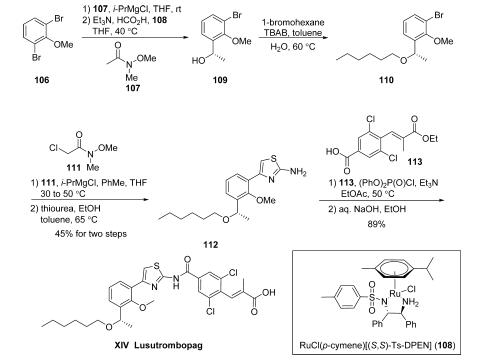To date, only two synthetic routes to lusutrombopag have
been reported: one in the Japanese patent literature which has
been exemplified on kilogram scale and the other a closely
related discovery route which has been reported in the United
States patent literature. Commercial 2,6-dibromoanisole
(106) was treated with isopropylmagnesium chloride to form
the corresponding Grignard reagent prior to reaction with
Weinreb amide 107, furnishing a ketone which underwent
immediate reduction with formic acid in the presence of chiral
catalyst RuCl(p-cymene)[(S,S)-Ts-DPEN] (108) and generate
the desired (S)-stereogenic alcohol 109.

Unfortunately, neither
the yield nor the stereoselectivity of this reduction was reported
in any of the disclosures. Benzyl alcohol 109 was subjected to
Williamson etherification conditions with n-hexyl bromide to
furnish ether 110. The aryl bromide within 110 was then
converted to the corresponding Grignard reagent, which was
reacted with N-methyloxy-N-methyl-2-chloroacetamide (111),
followed by subsequent treatment with thiourea in toluene/
ethanol at elevated temperatures to give aminothiazole
intermediate 112 in 45% yield across the two-step sequence.
Next, activation of acid 113 prior to exposure to 112 facilitated
amide bond formation. Saponification of the pendant ester with
sodium hydroxide furnished luxutrombopag (XIV) in 89%
yield. Although acid 113 is not commercial, it could be
prepared from 3,5-dichlorobenzoic acid (33) via formylation
with 4-formylmorpholine, followed by a Horner-Wadsworth-Emmons reaction with triethylphosphonopropionate.




